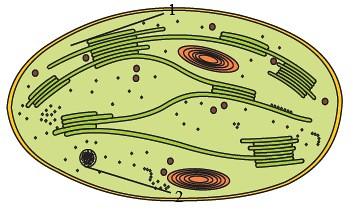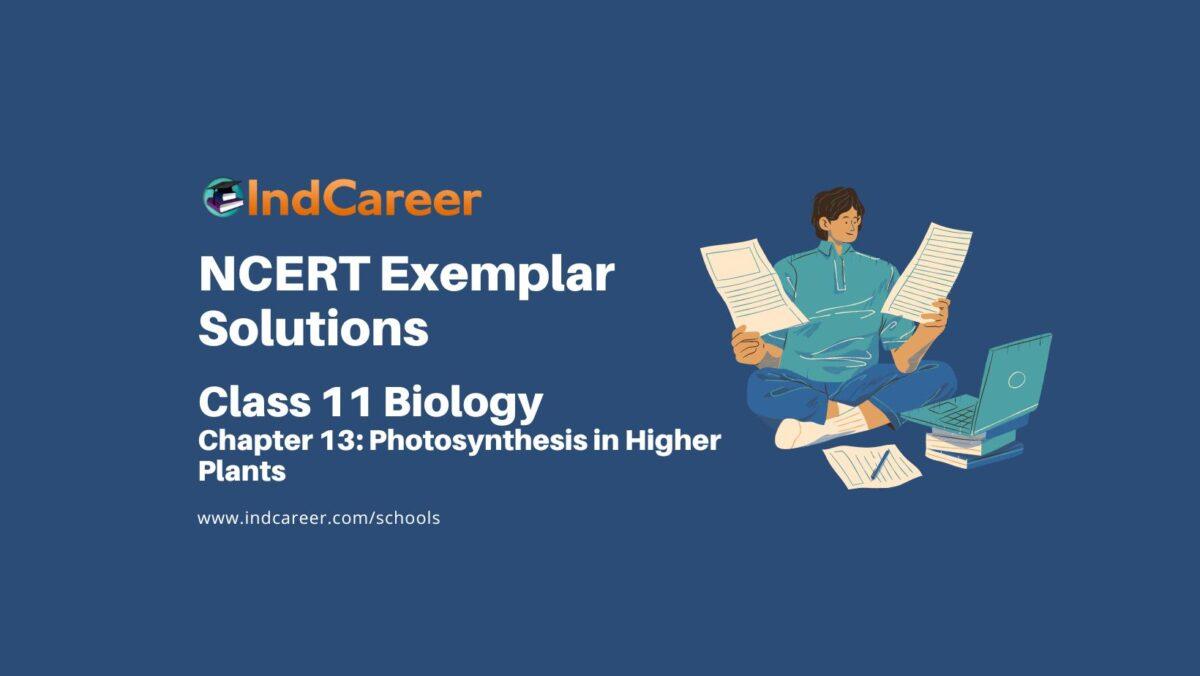NCERT Exemplar Class 11 Biology Chapter 13: Photosynthesis in Higher Plants. NCERT Exemplar Solutions for Class 11 Biology Chapter 13 Photosynthesis in Higher Plants prepare students for their Class 11 exams thoroughly.
Biology problems and solutions for the Class 11 pdf are provided here which are similar to the questions being asked in the previous year’s board.
NCERT Exemplar Class 11 Biology Chapter 13: Photosynthesis in Higher Plants
Class 11: Biology Chapter 13 solutions. Complete Class 11 Biology Chapter 13 Notes.
Multiple Choice Questions
- Which metal ion is a constituent of chlorophyll?
- a. Iron
- b. Copper
- c. Magnesium
- d. Zinc
- Which pigment acts directly to convert light energy to chemical energy?
- a. Chlorophyll a
- b. Chlorophyll b
- c. Xanthophyll
- d. Carotenoid
- Which range of wavelength (in nm) is called photosynthetically active radiation (PAR)?
- a. 100 – 390
- b. 390 – 430
- c. 400 – 700
- d. 760 – 100,00
- Which light range is most effective in photosynthesis?
- a. Blue
- b. Green
- c. Red
- d. Violet
- Chemosynthetic bacteria obtain energy from
- a. Sun
- b. Infra red rays
- c. Organic substances
- d. Inorganic chemicals
- Energy required for ATP synthesis in PSII comes from
- a. Proton gradient
- b. Electron gradient
- c. Reduction of glucose
- d. Oxidation of glucose
- During light reaction in photosynthesis the following are formed:
- a. ATP and sugar
- b. Hydrogen, O2 and sugar
- c. ATP, hydrogen donor and O2
- d. ATP, hydrogen and O2 donor
- Dark reaction in photosynthesis is called so because
- a. It can occur in dark also
- b. It does not depend on light energy
- c. It cannot occur during day light
- d. It occurs more rapidly at night
- PEP is primary CO2 acceptor in
- a. C4 plants
- b. C3 plants
- c. C2 plants
- d. Both C3 and C4 plants
- Splitting of water is associated with
- a. Photosystem I
- b. Lumen of thylakoid
- c. Both Photosystem I and II
- d. Inner surface of thylakoid membrane
- The correct sequence of flow of electrons in the light reaction is
- a. PSII, plastoquinone, cytochromes, PSI, ferredoxin
- b. PSI, plastoquinone, cytochromes, PSII, ferredoxin
- c. PSI, ferredoxin, PSII,
- d. PSI, plastoquinone, cytochromes, PSII, ferredoxin
- The enzyme that is not found in a C3 plant is
- a. RuBP Carboxylase
- b. PEP Carboxylase
- c. NADP reductase
- d. ATP synthase
- The reaction that is responsible for the primary fixation of CO2 is catalysed by
- a. RuBP carboxylase
- b. PEP carboxylase
- c. RuBP carboxylase and PEP carboxylase
- d. PGA synthase
- When CO2 is added to PEP, the first stable product synthesised is:
- a. Pyruvate
- b. Glyceraldehyde-3-phosphate
- c. Phosphoglycerate
- d. Oxaloacetate
Very Short Answer Type Questions
- Examine the figure

- a. Is this structure present in animal cell or plant cell?
- b. Can these be passed on to the progeny? How?
- c. Name the metabolic processes taking place in the places marked (1) and (2).
- 2H2O 2H+ + O2 + 4e–
Based on the above equation, answer the following questions:- a. Where does this reaction take place in plants?
- b. What is the significance of this reaction?
- Cyanobacteria and some other photosynthetic bacteria don’t have chloroplasts. How do they conduct photosynthesis?
- a. NADP reductase enzyme is located on .
b. Breakdown of proton gradient leads to release of . - Can girdling experiments be done in monocots? If yes, How? If no, why not?
- 3CO2 + 9ATP + 6NADPH + Water glyceraldehyde 3 – phosphate + 9 ADP + 6 NADP+ + 8 Pi
Analyze the above reaction and answer the following questions:- a. How many molecules of ATP & NADPH are required to fix one molecule of CO2?
- b. Where in the chloroplast does this process occur?
- Does moonlight support photosynthesis? Find out.
- Some of these terms/chemicals are associated with the C4 cycle. Explain.
- a. Hatch slack pathway
- b. Calvin cycle
- c. PEP carboxylase
- d. Bundle sheath cells
- Where is NADP reductase enzyme located in the chloroplast? What is the role of this enzyme in proton gradient development?
- ATPase enzyme consists of two parts. What are those parts? How are they arranged in the thylakoid membrane? Conformational change occur in which part of the enzyme?
- Which products formed during the light reaction of photosynthesis are used to drive the dark reaction?
- What is the basis for designating C3 and C4 pathways of photosynthesis?
Short Answer Type Questions
- Succulents are known to keep their stomata closed during the day to check transpiration. How do they meet their photosynthetic CO2 requirements?
- Chlorophyll ‘a’ is the primary pigment for light reaction. What are accessory pigments? What is their role in photosynthesis?
- Do reactions of photosynthesis called, as ‘Dark Reaction’ need light? Explain.
- How are photosynthesis and respiration related to each other?
- If a green plant is kept in dark with proper ventilation, can this plant carry out photosynthesis? Can anything be given as supplement to maintain its growth or survival?
- Photosynthetic organisms occur at different depths in the ocean. Do they receive qualitatively and quantitatively the same light? How do they adapt to carry out photosynthesis under these conditions?
- In tropical rain forests, the canopy is thick and shorter plants growing below it, receive filtered light. How are they able to carry out photosynthesis ?
- What conditions enable Rubis CO to function as an oxygenase? Explain the ensuing process.
- Why does the rate of photosynthesis decrease at higher temperatures?
- Explain how during light reaction of photosynthesis, ATP synthesis is a chemiosmotic phenomenon.
- Find out how Melvin Calvin worked out the complete biosynthetic pathway for synthesis of sugar.
- Six turns of Calvin cycle are required to generate one mole of glucose. Explain.
- Complete the flow chart for cyclic photophosphorylation of the photosystem-I

- In what kind of plants do you come across ‘Kranz’ anatomy? To which conditions are those plants better adapted? How are these plants better adapted than the plants, which lack this anatomy?
- A process is occurring throughout the day, in ‘X’ organism. Cells are participating in this process. During this process ATP, CO2 and water are evolved. It is not a light dependent process.
- a. Name the process.
- b. Is it a catabolic or an anabolic process?
- c. What could be the raw material of this process?
- Tomatoes, carrots and chillies are red in colour due to the presence of one pigment. Name the pigment. Is it a photosynthetic pigment?
- Why do we believe chloroplast and mitochondria to be semi-autonomous organelle?
- Observe the diagram and answer the following.

- a. Which group of plants exhibits these two types of cells?
- b. What is the first product of C4cycle?
- c. Which enzyme is there in bundle sheath cells and mesophyll cells?
- A cyclic process is occurring in C3 plant, which is light dependent, and needs O2. This process doesn’t produce energy rather it consumes energy.
- a. Can you name the given process?
- b. Is it essential for survival?
- c. What are the end products of this process?
- d. Where does it occur?
- Suppose Euphorbia and Maize are grown in the tropical area.
- a. Which one of them do you think will be able to survive under such conditions?
- b. Which one of them is more efficient in terms of photosynthetic activity?
- c. What difference do you think are there in their leaf anatomy?
Long Answer Type Questions
- Is it correct to say that photosynthesis occurs only in leaves of a plant? Besides leaves, what are the other parts that may be capable of carrying out photosynthesis? Justify.
- The entire process of photosynthesis consists of a number of reactions. Where in the cell do each of these take place?
- a. Synthesis of ATP & NADPH __________________________
- b. Photolysis of water __________________________
- c. Fixation of CO2 __________________________
- d. Synthesis of sugar molecule __________________________
- e. Synthesis of starch __________________________
- Which property of the pigment is responsible for its ability to initiate the process of photosynthesis? Why is the rate of photosynthesis higher in the red and blue regions of the spectrum of light?
- What can we conclude from the statement that the action and absorption spectrum of photosynthesis overlap? At which wavelength do they show peaks?
- Under what conditions are C4 plants superior to C3?
- In the figure given below, the black line (upper) indicates action spectrum for photosynthesis and the lighter line (lower) indicates the absorption spectrum of chlorophyll a, answer the followings:

- a. What does the action spectrum indicate? How can we plot an action spectrum? Explain with an example.
- b. How can we derive an absorption spectrum for any substance?
- c. If chlorophyll a is responsible for light reaction of photosynthesis, why do the action spectrum and absorption spectrum not overlap?
- What are the important events and end products of the light reaction?
- In the diagram shown below label A, B, C. What type of phosphorylation is possible in this?

- Why is the RuBisCo enzyme more appropriately called RUBP Carboxylase-Oxygenase and what important role does it play in photosynthesis?
- What special anatomical features are displayed by leaves of C4 plants? How do they provide advantage over the structure of C3 plants
- Name the two important enzymes of C3 and C4 pathway, respectively? What important role do they play in fixing CO2?
- Why is RuBisCo enzyme the most abundant enzyme in the world?
- Why does not photorespiration take place in C4 plants?
Answers to Multiple Choice Questions
| 1- c; | 2- a; | 3-c; | 4- c; | 5- d; | 6- a; |
| 7- c; | 8- a; | 9- a; | 10- d; | 11 -a; | 12 -b; |
| 13 -c; | 14-d |
